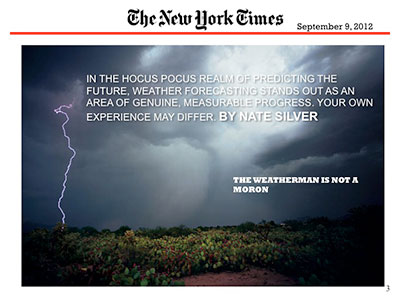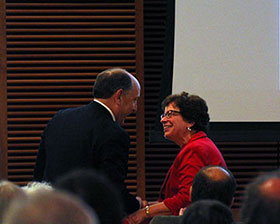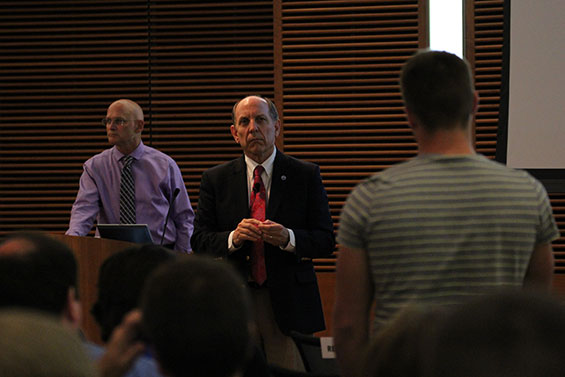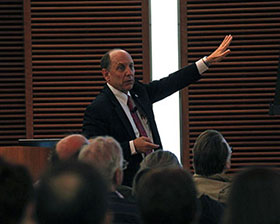A Weather-Ready Nation Vision: Improving Forecasts, Communication, and Cooperation
Weather predictions matter. And as it turns out, it’s more than just accurately forecasting the weather and issuing timely warnings. Equally important is ensuring that decision makers and the public understand and appreciate the messages so that they take timely, appropriate action. To further complicate the issue, it’s about creating the awareness of the impact of weather across disciplines, affecting countless areas of our lives – from health to ecology to industry. It’s a tall order. However, as National Weather Service (NWS) Director Dr. Louis Uccellini made clear at the Weather-Ready Nation Town Hall last night on the UW-Madison campus, he and the NWS as a whole are committed to tackling this challenge.
First, let’s be honest. We’ve all grumbled about the weather, or more specifically, about a blown forecast. It happens. What Dr. Uccellini suggested to the audience was the need to view the forecasting issue from another perspective.
Uccellini began by citing an article written by Nate Silver for the NY Times Magazine in 2012. The title of the article is rather telling: “The Weatherman Is Not a Moron.” Uccellini noted that Silver holds up weather forecasting as a “premier example of measurable progress” in our ability to make accurate predictions of, really, any kind. Numerical models have improved significantly allowing forecasters to make better use of the data. Another key has been for forecasters to acknowledge the uncertainty in the forecast, which allows the public to have greater confidence in the forecast.

Slide from Dr. Uccellini’s talk referencing Nate Silver’s “The Weatherman Is Not a Moron” article that appeared in the NY Times Magazine in 2012.
Continuing to make his case for a new perspective, Uccellini detailed a number of severe weather events and the difficulty in getting the observations needed to make a prediction, let alone having the capability to warn the public in advance. The so-called “Children’s Blizzard” of 1888, which was completely unforecasted, left 235 dead; the only data available were surface observations which had to be transmitted via telegraph lines. The 1900 hurricane that devastated Galveston, TX and left more than 6000 dead was missed due to “poor analysis of current conditions.”
Describing how forecasts are made today, Uccellini highlighted the three essential components: the global observing system, computers, and data assimilation plus modeling/science. Uccellini noted that the NWS takes in roughly two billion observations every day, and 99.9% of the data is remotely sensed, mostly from satellites. “SSEC rightly deserves credit for this,” commented Uccelini, referring to the legacy of SSEC founder Vern Suomi, the “Father of Satellite Meteorology.” “This was his [Suomi’s] dream.”
Recent severe weather events have provided interesting case studies for the accuracy of weather predictions and how people react to warnings.
In February 2010 “Snowmageddon” dumped four feet of snow in the DC area. Forecasters issued warnings on the storm system seven days in advance, with specific warnings on the potential for heavy snow three to five days in advance. Uccellini noted that because of such early notice states were able to implement COOP (continuity of operations) plans, airlines were able to cancel flights and protect their aircraft (consequently, allowing them to return to their normal schedules more quickly), and the retail industry stocked shelves ahead of the storm.

UW-Madison Chancellor Rebecca Blank greets Dr. Uccellini at the Weather-Ready Nation Town Hall. Photo credit: Bill Bellon
Last year’s Sandy provides a more recent example of extreme weather, and one on a much larger scale. Uccellini detailed the impacts of the storm system, from peak wind gusts (exceeding hurricane force winds) to total precipitation to storm surge to snow depth (the first time snow warnings have been issued in conjunction with a hurricane). He also noted the communication strategy the NWS employed, how they focused on the impacts – the unique nature of the storm, the large area that would be affected, and comparisons to the Perfect Storm, plus the additional task of convincing people that there would be significant snow in West Virginia. Despite the complex nature of creating and disseminating accurate forecasts, Uccellini is convinced that they saved lives and allowed people to get out of harm’s way in time in this particular case; “I have no doubt about that.”
Sandy is providing a good case study for how forecasters can better predict the hurricane’s track. For example, creating an ensemble forecast based on a number of forecasts is critical to more accurately track a hurricane’s progress. Operational computing capacity is another key area for improvements. For example, in 2012 their operational computer could process 73 trillion calculations per second but transition to a new system in July 2013 boosted that capacity to 208 trillion calculations per second. The plan is to be able to process 1900 trillion calculations per second by 2015.
In December 2011 the NWS organized a workshop in Norman, OK to discuss this concept of a weather-ready nation, how we all need to work together as a team to prepare for severe weather. Social scientists were brought in to provide expertise on how people make decisions in response to severe weather and warnings. A surprising discovery was that the general public doesn’t interpret warnings the same way that NWS forecasters do; the two groups operate with different definitions of the term “warning.”
The NWS now emphasizes its role in decision support services, recognizing the need to move beyond the forecast itself. Similarly, weather predictions can be extended to other sciences, such as hydrology to study flooding or ecology. Taking a broader approach allows scientists to forecast water quality or the potential for disease outbreaks.

Dr. Uccellini listens to a question at the Weather-Ready Nation Town Hall. Photo credit: Bill Bellon
During the question and answer session, Uccellini was able to return to many of these same points. He again noted the efforts of scientists in the satellite research community, and at UW-Madison in particular, and how the NWS could “provide a better catcher’s mitt” to help their work come to fruition. Assimilating data remains a “huge mathematical problem.” Despite these challenges, improvements in the ability to forecast events are possible, as far as 14 days in advance, though continuing to express the amount of uncertainty in these forecasts is vital. Similarly important is the cooperation between agencies and communities to prepare for severe weather, as well as the cooperation between countries to share remotely sensed data, “the backbone of our observing system.”
Social media and cell phones continue to play a larger role in disseminating information, whether through official NWS feeds or through amateur observations. In some cases the NWS has been able to confirm their forecasts through comments by others on social media.
Uccellini ended the night with some thoughts on education, particularly for future atmospheric science students. He referenced efforts to involve teachers through American Meteorological Society workshops and projects to bring data into their schools (DataStreme) and the critical role universities play in educating the next generation of weather scientists. He noted tremendous progress in the field and saw hope in holistic approaches that examine the Earth System, predicting that “this is where advances will come in the future.” He then returned to the importance of communication – students need to write and speak well so that the message they intend to convey is the message received. The public and decision makers will depend on them and must have confidence in that message.
As predictions continue to improve over time, Uccellini reiterated that clearly communicating the forecast impacts and the uncertainty will help the NWS fulfill its role in creating a weather-ready nation. Working together, agencies, local communities, and the public can help to make that vision a reality.
by Leanne Avila
UPDATE: Dr. Uccellini’s Town Hall is now available for viewing online.

